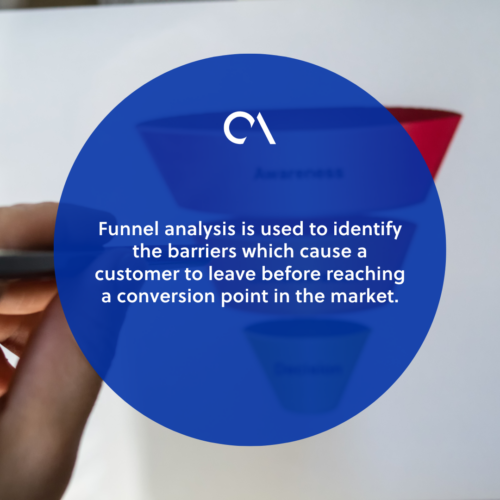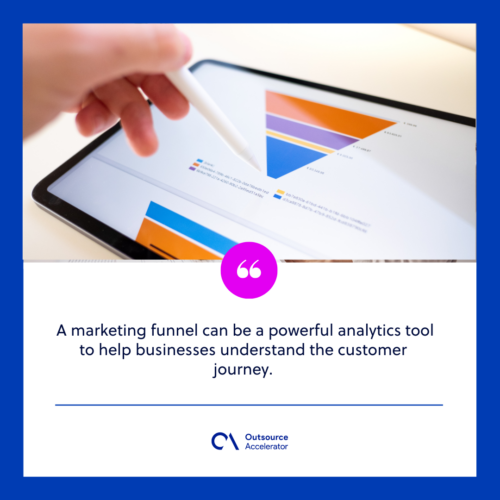Grow your website conversion rate with funnel analysis

Website and page visitors flow through your website daily. Most marketers are interested in determining the percentage of visitors who continue to the next user journey step.
Marketers calculate the conversion rate across the entire funnel using a funnel report through funnel analysis. This is done to determine the percentage of potential customers that visits the company’s website.
Read further to learn about the importance of funnel analysis, how to enhance overall user experience, and how it can level up your conversion rate.
What is funnel analysis?
Funnel analysis is used to analyze website traffic[1] and understand user behavior. It is also used in calculating conversion rates.
Usually, product managers use a funnel analysis to create a visual map and trace the step-by-step journey of the users through a website funnel, social media pages, and mobile application.
The set of steps mentioned is referred to as a funnel because its shape narrows towards the end, just like a ‘physical funnel.’ The number of visitors at the top is larger than that of visitors at the bottom.
Further, funnel analysis is used to identify the barriers which cause a customer to leave before reaching a conversion point in the market.

Importance of funnel analysis
The importance of funnel analysis is centered on monitoring user behavior and revealing the customers’ intentions and what motivates them to visit the website.
A company supports multiple digital interactions such as websites, email, mobile applications, and dashboards. Funnel analysis helps streamline these digital media for the best user experience.
However, funnel analysis is not just important in sales and marketing. It is also important to grow customer retention[2] by optimizing marketing campaigns based on funnel reports.
Two main benefits of funnel analysis
Funnel analysis presents many ways to extract insights from an organization’s data and website traffic. The following are the main benefits of using funnel analysis:
Identifies where high-quality visitors come from
Funnel analysis can help find where high-converting traffic comes from through analytics tools such as Google Analytics.
This allows you to gain deeper insights by performing advanced funnel analysis.
Helps find traffic
Funnel analysis helps find website traffic via a funnel visualization tool. A funnel visualization tool shows the drop-off rate and conversion rate of your company’s main pages.
The whole process of funnel analysis using a visualization tool will help you understand where and when visitors, as potential customers, are leaving your website.
Types of funnel analysis
With funnel analysis, you can analyze and optimize your marketing funnel to understand the effectiveness of your campaigns and customer acquisition and retention strategies.
There are several parts of your business where you can apply this method, and below are some of the typical types of funnel analysis:
Onboarding funnel analysis
This type of funnel analysis is designed to help new users get started with the software. It provides guides, game walkthroughs, and trials.
Onboarding funnel analysis commonly has a free trial in their program. The ultimate goal of onboarding funnel analysis is to convert a free trial user into a paying customer.
Sales funnel analysis
A sales funnel analysis has stages–each has to offer specific information, content, or answers to help your prospects move closer to making a purchase.
It involves the following stages:
- Research and preparation. Getting to know the target customers.
- Brand awareness. Introducing the product or service through advertising, guest posting, podcast, or sponsored social media posts
- Interest and evaluation. Building relationships with new leads to determine what their end goals are.
- Desire. The purpose of this stage in the sales funnel aims to show the prospects what life would be like if they become your customers.
- Action. This sales funnel stage aims to provide users with educational materials that will help them become familiar with the software.
- Re-engagement. Re-engaging with existing users can positively impact their experience and encourage them to make additional purchases.
Marketing funnel analysis
From a strategic perspective, a marketing funnel can be a powerful analytics tool to help businesses understand the customer journey.
The steps in funnel analysis and how the number of users increases as they pass through these stages can be understood using the marketing funnel.
In other words, a marketing funnel analysis measures a brand’s success through a consumer’s journey.

Amp up your website conversion rate using funnel analysis
Funnels are amazing tools for gaining customer insight and boosting conversion rates.
Once you have already attained this basic knowledge about funnel analysis, you will now have a better sense of the steps that define your user by funnel stage.
Funnel analysis can be used alongside cohort analysis to dig deeper into why users aren’t converting.
Finding out the reason why there are customers who do not convert will give a company important insights about how to improve user experience and who to target in the future.
Leveraging a funnel analysis for growing your conversion rate may provide crucial information. It can report where your most frequent website visitors leave or which pages have the best Click-Through-Rates (CTR).
Article references
[2] Grow customer retention: Arslan, I Kahraman, “The importance of creating customer loyalty in achieving sustainable competitive advantage.” Eurasian Journal of Business Management; Istanbul, 2020 Vol. 8 (1), doi: 10.15604/ejbm.2020.08.01.002







 Independent
Independent




